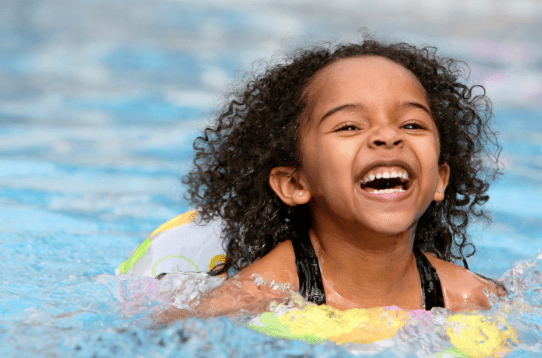| Summer is here and we’re ready for fun in the sun, splashing in our own pool with family or the community pool with friends. Water fun is great fun, but with this fun comes serious responsibility. Take precautions to help protect your child from drowning dangers.
Drowning in a home pool is the leading cause of accidental death in children ages 1-4 and the second-leading cause of injury-related deaths in children ages 1-14. African American children drown at rates almost 3 times that of white children. Non-fatal drowning injuries cause severe brain damage, with children left with long-term memory problems, learning disabilities and often in a permanent vegetative state.
How to Protect Your Child from Drowning Dangers
No parent wants to imagine that their child is going to get hurt when they take them to the pool or lake. But there is a chance that something bad can happen if you are not careful. Learning how to protect your child from drowning dangers will make sure that everyone is safe.
Follow these simple steps rigorously and at all times to keep your children safe:
Supervise your child vigilantly when they are in or around water.
Drowning happens quickly and quietly, so stay focused on your child, even if just splashing in a plastic pool with a few inches of water; no yard work, no phone calls, no reading. For pre-school children, stay close enough to reach out and touch your child at all times.
“Wings” or toys do not keep kids safe.
Water wings, noodles, chairs or other items that float are not safety devices. Even if your child is wearing water wings, keep your eyes on them at all times. These items are not meant to keep children safe. They deflate easily and are unstable, putting your child in danger.
To protect your child from drowning dangers, you should be in the water with them. Try to stay arm’s length or less away from them. Invest in swimming lessons so they are able to learn how to swim without assistance.
Secure the area immediately after play.
Put toys and floats away in a secure area immediately after use so children are not tempted to use the pool unsupervised. Drain your plastic or inflatable “kiddie pool” before you leave the sight of it.
You should have a secure method to protect your child if no one is around the pool. It only takes a little amount of time for a child to get out to the pool and fall in without you noticing. Have a plan in place and extra safety features to protect your child from drowning dangers.
Fencing is mandatory.
Install a fence that completely separates the pool from your house and yard. The fence should be a minimum of 4 feet high and include self-closing and self-locking gates that are out of reach of children. We strongly recommend an alarm that will sound if someone enters the pool area and a hard cover for in-ground pools, closed when the pool is not in active use.
Water safety classes are a must.
Your children should take swimming lessons as soon as possible to reduce the risk of drowning. However, be aware that swimming lessons are not a substitute for your constant supervision.
If you would like to protect your child from drowning dangers, you need to take the time to teach your child how to swim on their own. Get them signed up from a young age.
Learn your CPR!
If an accident does happen, your knowledge of Cardiopulmonary Resuscitation (CPR) can save a life or help reduce brain damage.
Concerned about your CPR skills? Call Alzein Pediatrics and we’ll help you find a class or give you a refresher lesson at your next appointment! |
